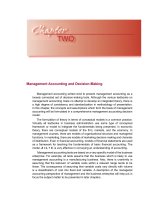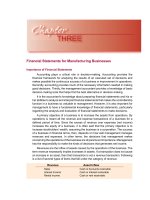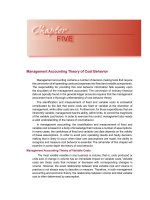Nen Tang Cua Ke Toan Quan Tri Chaper 2
Bạn đang xem bản rút gọn của tài liệu. Xem và tải ngay bản đầy đủ của tài liệu tại đây (510.67 KB, 16 trang )
Management Accounting
| 15
Management Accounting and Decision-Making
Management accounting writers tend to present management accounting as a
loosely connected set of decision‑making tools. Although the various textbooks on
management accounting make no attempt to develop an integrated theory, there is
a high degree of consistency and standardization in methodology of presentation.
In this chapter, the concepts and assumptions which form the basis of management
accounting will be formulated in a comprehensive management accounting decision
model.
The formulation of theory in terms of conceptual models is a common practice.
Virtually all textbooks in business administration use some type of conceptual
framework or model to integrate the fundamentals being presented. In economic
theory, there are conceptual models of the rm, markets, and the economy. In
management courses, there are models of organizational structure and managerial
functions. In marketing, there are models of marketing decision‑making and channels
of distribution. Even in nancial accounting, models of nancial statements are used
as a framework for teaching the fundamentals of basic nancial accounting. The
model, A = L + C, is very effective in conveying an understanding of accounting.
Management accounting texts are based on a very specic model of the business
enterprise. For example, all texts assume that the business which is likely to use
management accounting is a manufacturing business. Also, there is unanimity in
assuming that the behavior of variable costs within a relevant range tends to be
linear. The consequence of assuming that variable costs vary directly with volume
is a classication of cost into xed and variable. A description of the managerial
accounting perspective of management and the business enterprise will help put in
focus the subject matter to be presented in later chapters.
16 |
CHAPTER TWO
•
Management Accounting and Decision-Making
The Management Accounting Perspective of the Business Enterprise
The management accounting view of business may be divided into two broad
categories: (1) basic features and (2) basic assumptions.
Basic Features
The business rm or enterprise is an organizational structure in which the basic
activities are departmentalized as line and staff. There are three primary line functions:
marketing, production, and nance. The organization is run or controlled by individuals
collectively called management. The staff or advisory functions include accounting,
personnel, and purchasing and receiving. The organization has a communication or
reporting system (e.g. budgeting) to coordinate the interaction of the various staff
and line departmental functions. The environment in which the organization operates
includes investors, suppliers, governments (state and federal), bankers, accountants,
lawyers, competitors, etc.)
The organizational aspect of the business rm is illustrated in Figure 2.1. This
descriptive model shows that there are different levels of management. A commonly
used approach is to classify management into three levels: Top management, middle
management, and lower level management. The signicance of a hierarchy of
management is that decision‑making occurs at three levels.
Basic Assumptions in Management Accounting
The framework of management accounting is based on a number of implied
assumptions. Although no single work has attempted to identify all of the assumptions,
Board of
Directors
President
Vice-President
Production
Manager
Finishing Dept.
Manager
Cutting Dept
Manager
Finishing Dept.
Vice-President
Finance
Vice-President
Marketing
Accounting
Department
Income
Statement
Balance Sheet
Figure 2.1 • Conventional Organizational Chart
Management Accounting
| 17
the major assumptions will be detailed below. Five categories of assumptions will be
presented:
1. Basic goals
2. Role of management
3. Nature of Decision‑making
4. Role of the accounting department
5. Nature of accounting information
Basic Goal Assumptions -
The basic goals or objectives the business enterprise
may be multiple. For example, the goal may be to maximize net income. Other goals
could be to maximize sales, ROI, or earnings per share. Management accounting
does not require a specic of type of goal. However, whatever form the goal takes,
management will at all times try to achieve a satisfactory level of prot. A less than
satisfactory level of prot may portend a change in management.
Role of Management Assumptions -
The success of the business depends
primarily upon the skill and abilities of management–which skills can vary widely
among different managers. The business is not completely at the mercy of market
forces. Management can through its actions (decisions) inuence and control events
within limits. In order to achieve desired results, management makes use of specic
planning and control concepts and techniques. Planning and control techniques
which management may use include business budgeting, cost‑volume‑prot
analysis, incremental analysis, exible budgeting, segmental contribution reporting,
inventory models, and capital budgeting models. Management, in order to improve
decision‑making and operating results, will evaluate performance through the use of
exible budgets and variance analysis.
Decision-making Assumptions - A critical managerial function is decision‑
making. Decisions which management must make may be classied as marketing,
production, and nancial. Decisions may also be classied as strategic and tactical
and long‑run and short‑run. A primary objective of decision‑making is to achieve
optimum utilization of the business’s capital or resources. Effective decision‑making
requires relevant information and special analysis of data.
Accounting Department Assumptions - The accounting department is a primary
source of information necessary in making‑decisions. The accounting department
is expected to provide information to all levels of management. Management will
consider the accounting department capable of providing data useful in making
marketing, production, and nancial decisions.
Nature of Accounting Information - In order for the accounting department to
make meaningful analysis of data, it is necessary to distinguish between xed and
variable costs and other types of costs that are not important in the recording of
business transactions. Some but not all of the information needed by management can
be provided from nancial statements and historical accounting records. In addition to
historical data, management will expect the management accountant to provide other
types of data, such as estimates, forecasts, future data, and standards. Each specic
18 |
CHAPTER TWO
•
Management Accounting and Decision-Making
managerial technique requires an identiable type of information. The accounting
department will be expected to provide the information required by a specic tool. In
order for the accounting department to make many types of analysis, a separation of
costs into xed and variable will be required. The management accountant need not
provide information beyond the relevant range of activity.
Implications of the Basic Assumptions
The assumption that there are three types of decisions,( marketing, production,
and nancial) requires that management identify the specic decisions under each
category. The identication of specic decisions is critical because only then can the
appropriate managerial accounting technique be properly used.
Some typical management decisions of a manufacturing business include:
Marketing Production Financial
Pricing Units of equipment Issue of bonds
Sales forecast Factory workers’ wages Issue of stock
Number of sales people Overtime, second shift Bank loan
Sales people compensation Replacement of equipment Retirement of bonds
Number of products Inventory levels Dividends
Advertising Order size Investment in securities
Credit Suppliers
An understanding of nancial statements is critical to the ability of management
to make good decisions. Financial statements, although prepared by accountants,
are actually created by management through the implementation of decisions. The
historical data from which accountants prepare nancial statements result from actual
management decisions. The reader and user of nancial statements is not primarily
the accountant but management. From a management accounting point of view, it is
management rather than accountants that needs to have the greater understanding
of nancial statements.
The income statement and the balance sheet can be viewed as a descriptive
model for decision‑making. Financial statements reect success or lack of success
in making decisions. Management can be deemed successful when the desired
income has been attained and nancial position is considered sound. To achieve
managerial success management must manage successfully the assets, liabilities,
capital, revenue and expenses. Financial statements, then, serve as a ready and
convenient check list of decision‑making areas.
The basic balance sheet equation, of course, is A = L + C. A management
accounting interpretation is that the assets or resources come from the creditors
(liabilities) and the owners (capital). It is management responsibilities to manage
both sides of the equation. That is, management must make decisions about both the
resources (assets) and the sources of the assets (liabilities and capital).
Each item on the balance sheet is an area of management. Stated differently each
item on nancial statements represents a critical area sensitive to mismanagement.
Management Accounting
| 19
Cash, accounts receivable, inventory, xed assets, accounts payable, etc. can be too
large or too small. Given this fact, then, for each item there must be the right amount
or optimum. It is management’s responsibility to make the best decision possible
regarding each item on the nancial statements. Gross mismanagement of any single
item could either result in the failure of the business or the downfall of management.
Following are some examples of decisions associated with specic nancial
statement items:
Balance Sheet Items Decision
Cash Minimum level
Accounts receivable Credit terms
Inventory Order size
Fixed asset Capacity size
Bonds payable Amount and interest rate
Income Statement Items
Sales Price, number of products, number
of sales people
Salesmen compensation Salaries and commission rate
Advertising Media, advertising budget
The statement that the management accountant will be required to furnish
information not of a historical nature means that the accountant will have to deal
with planned and estimated or future data. Furthermore, much of this data will be
not be found in the historical data bank from which the accountant prepares nancial
statements. The management accountant may be required to do analysis requiring
data of an economic nature. For example, analysis of pricing may require data
about the company’s demand curve. Labor cost analysis may require estimating the
productivity of labor relative to various wage rates.
Decision-making in Management Accounting
In management accounting, decision‑making may be simply dened as choosing
a course of action from among alternatives. If there are no alternatives, then no
decision is required. A basis assumption is that the best decision is the one that
involves the most revenue or the least amount of cost. The task of management with
the help of the management accountant is to nd the best alternative.
The process of making decisions is generally considered to involve the following
steps:
1 Identify the various alternatives for a given type of decision.
2. Obtain the necessary data necessary to evaluate the various alternatives.
3. Analyze and determine the consequences of each alternative.
4. Select the alternative that appears to best achieve the desired goals or
objectives.
5. Implement the chosen alternative.
6. At an appropriate time, evaluate the results of the decisions against
standards or other desired results.
20 |
CHAPTER TWO
•
Management Accounting and Decision-Making
From the descriptive model of the basic features and assumptions of the
management accounting perspective of business, it is easy to recognize that
decision‑making is the focal point of management accounting. The concept of
decision‑making is a complex subject with a vast amount of management literature
behind it. How businessmen make decisions has been intensively studied. In
management accounting, it is useful to classify decisions as:
1. Strategic and tactical
2. Short‑run and long‑run
Strategic and Tactical Decisions
In management accounting, the objective is not necessarily to make the best
decision but to make a good decision. Because of complex interacting relationships,
it is very difcult, even if possible, to determine the best decision. Management
decision‑making is highly subjective.
Whether a decision is good or acceptable depends on the goals and objectives of
management. Consequently, a prerequisite to decision‑making is that management
have set the organization’s goals and objectives. For example, management must
decide strategic objectives such as the company’s product line, pricing strategy,
quality of product, willingness to assume risk, and prot objective.
In setting goals and objectives, it is useful to distinguish between strategic and
tactical decisions. Strategic decisions are broad‑based, qualitative type of decisions
which include or reect goals and objectives. Strategic decisions are non quantitative
in nature. Strategic decisions are based on the subjective thinking of management
concerning goals and objectives.
Tactical decisions are quantitative executable decisions which result directly from
the strategic decisions. The distinction between strategic and tactical is important in
management accounting because the techniques of management accounting pertain
primarily to tactical decisions. Management accounting does not typically provide
techniques for assisting in making strategic decisions.
Examples of strategic decisions and tactical decisions from a management
accounting point of view include:
Decision items Strategic Decisions Tactical Decisions
Cash Maintain minimum level
without excessive risk Specic level of cash
Accounts receivable Sell on credit Specic credit terms
Inventory Maintain safety stock Specic level of inventory
Price Be volume dealer by Specic price
setting price lower than
competition
Once a strategic decision has been made, then a specic management tool can be
used to aid in making the tactical decision. For example, if the strategic decision has
been made to avoid stock outs, then a safety stock model may be used to determine
the desired level of inventory.









